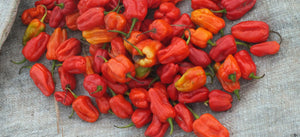With African origins and a Swahili name meaning pepper, this African jewel of 175,000 SHU is flavouring chicken and meals all around the world. Yes, we specifically mentioned chicken. Ever heard of the famous piri piri chicken? Well the star of this dish is the delicious piri piri sauce giving each mouthful a tasty punch.
Scoville scale (SHUs) |
50,000 to 175,000 SHUs |
Claim to Fame |
Portuguese Peri Peri Chicken |
Often this chili is referred to as the African Bird’s-Eye Pepper or African Red Devil because even though it’s a small pepper, it has a surprising kick. Fully grown they are only 1 to 2 cm long and 1 cm wide.
So how did it get from Africa to a chicken dish?
It grows natively in the lower two-thirds of the African continent, primarily cultivated in Zambia and Zimbabwe. In the 15th century Portuguese settlers found it, and during the Mozambican and Angola Wars of Independence many Portuguese brought it back to Europe and around the world. So today it’s not only common in African and Portuguese meals but also widely used in Asian and latin cuisine. (In South America it is referred to as the malagueta.)
How is it used:
Firstly, think about where exactly you have heard of this famous piri piri chicken. Most likely your answer is Nandos. It’s a key ingredient to almost everything Nando’s serves. Makes sense, considering Nandos has African-Portuguese origins. Nandos mixes Peri Peri with salt, garlic, lemon, onion, oil and vinegar to make their signature sauce. You’ll find many of the chicken dishes on Nandos’ menus will be marinated with peri peri sauce.
Chicken is one of the best combinations for Piri Piri sauce. Either a marinade or glaze is a great way to garnish the chicken allowing the Piri Piri is soak into the poultry or simply rest on top adding the right pinch of heat. Consider glazing other white meats with the Piri Piri, such as fish or shellfish.
Your options don’t stop here. It’s also a great combination with a range of vegetables you can pop to bake in the oven, such as potato, cauliflower and carrots. If your family likes a little tang every now and then, piri piri seasoning is always a pleasant surprise.
Don’t limit yourself just to its use as a sauce. It’s also ideal for drying and using as a chili powder. If you ever want to substitute the chili mentioned in your recipe, Piri Piri is a spicier alternative for Cayenne powder. If you’re looking for a chili on the same level, Pequin Pepper and Thai Chilies are easier to find than the Peri Peri and will give you a similar heat kick.
Piri Piri is a great addition to many meals as you will only really feel the heat at the end of your mouthful, giving you a chance to appreciate all the flavours of the dish.
How hot are we talking:
Piri Piri chilli sits at 50,000 to 175,000 on the Scoville Heat scale. In regards to the Habanero, this barely compares to even the mildest Habanero type. However, in comparison to the jalapeños, it’s 20 times hotter.
While this might not be much compared to the 2,000,000 SHU of the Carolina Reaper, the Hottest Chili on record, it shouldn’t be taken lightly. A man trying to impress his date at Nandos, requests the restaurant to put an ‘extra hot’ black flag on a plain chicken to “appear” macho. Yet his plan backfires and eating an actual extra hot chicken ends his date in tears. So 175,000 SHU isn’t an easy feat for the average person.
To find out more about other chilli favourites
| 7 Pot Chilli | Read the blog | Explore the range |
| Aji Chilli | Read the blog | Explore the range |
| Bhut Jolokia (Ghost Chilli) | Read the blog | Explore the range |
| Birdseye | Read the blog | Explore the range |
| Carolina Reaper | Read the blog | Explore the range |
| Cayenne | Read the blog | Explore the range |
| Fatalii | Read the blog | coming soon |
| Habanero | Read the blog | Explore the range |
| Jalapeño | Read the blog | Explore the range |
| Naga Viper | Read the blog | Explore the range |
| Piri Piri | Read the blog | coming soon |
| Scotch Bonnet | Read the blog | Explore the range |
| Trinidad Scorpion | Read the blog | Explore the range |
Image By Orrling [CC BY-SA 3.0] from Wikimedia Commons

